|
About Nagaland |
 |
Nagaland, a
rural state is situated in the extreme north east India.
Nagaland is one of the smallest state in India, with a total
area of 16,579 square km. This state is bordered by Assam in
the west and north, in the east by Myanmar (Burma), in the
north by Arunachal Pradesh, and in the south by Manipur. The
state is divided into seven districts which are Kohima, Phek,
Mokokchung, Wokha, Zunheloto, Twensang and Mon. Kohima is the
capital city of Nagaland. Its
colorful people, great verdant landscapes, cultural festivals
and tribes are a delightful combination for a delightful
holiday experience. Nagamese, Hindi, English, Chang are the various languages
which are spoken in Nagaland. Nagaland has a monsoon climate
with generally high humidity. The best time to visit Nagaland
is from September to April. The foreigners require area permit
to visit Nagaland.
|
|
| |
|
History of Nagaland |
|
Very little is
known about the early history of Nagaland. The British rule was
established over the area by the 1890, and head hunting, a
traditional practice, was outlawed. The Naga territory was
divided between Assam and the North East Frontier Agency after
Indian independence in 1947, despite of the movement which
provided the political union of all the Naga tribes. In 1957,
following violent incidents, the Indian government established a
single Naga administrative unit under Indian rule. The Naga
people responded by refusing to pay their taxes and by
conducting a campaign of sabotage. In 1960, the Indian
government agreed to make Nagaland a self-governing state within
India. Nagaland, the 16th state of the Indian Union was born on 1st Dec 1963. The Naga separatists
continued to show violent opposition and demanded for autonomy
and creation of a single administrative unit comprising all the
Naga inhabited areas spanning across some of the north eastern
states. The Naga rebels and the Indian government have agreed on
a ceasefire and peace talks are still going on. Nagaland has a
single-chamber Legislative Assembly with 60 seats. The state
sends two members to the Indian national parliament, one to the
Rajya Sabha (upper house) and one to the Lok Sabha (lower
house). Mokokchung, Tuensang, Mon, Wokha, Zunheboto, Phek and
Kohima are seven local government administrative districts in
Nagaland. |
|
| |
|
Geography of Nagaland |
|
The terrain in
Nagaland is hilly, thickly wooded, rugged, and cut by deep river
valleys. The Naga Hills run through this small state. The
Saramati is the highest peak in Nagaland which is located at a
height of 3840 metres above sea level. The main rivers that flow
through Nagaland are Dhansiri, Doyang, Dikhu and Jhanji. The
terrain is mountainous, thickly wooded, and cut by deep river
valleys. There is no waterfall in Nagaland. The only well known
lake in Nagaland is Lacham, located to the east of Mehiri. The
hill sides are covered with green forests. The terraced fields
can be seen in the Angami region.
|
|
|
|
Festivals
of Nagaland |
|
The
festivals of Nagaland are mostly related to agricultural
operations. The community as a whole participate in the
festival celebrations. There is a definite programme that
stretch over a specified period in which all the village
folk join. The main festivals of Nagaland are Moatsu,
Sekrenyi, Sankarni. The Chakhesang Khilunyie and Rengma
Ngadah are the harvest festivals of Nagaland. The most
important festival of Aos is Moatsu, which is celebrated
after the sowing is over for six days. |
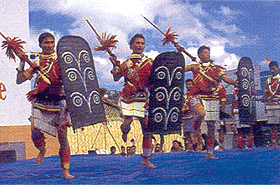 |
|
|
UP |
|
Places
in Nagaland |
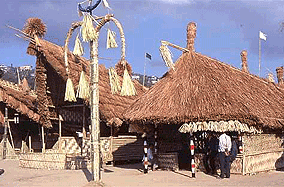 |
Kohima, the
capital city of the state of Nagaland, has a number of sites that are
worth visiting to get an insight of the place's rich history.
The World War II Cemetery that lies in a beautiful
surrounding, the Cathedral of Reconciliation, the Bara Basti, the Nagaland Museum, Nagaland Zoo
and Park are some of the attractions in Kohima. The sites near
Kohima include the tribal village of Khonoma, Dzulekie, Jopfu Peak, Dzukou Valley
and Dimapur.
|
|
| |
|
People
of Nagaland |
|
The people of
Nagaland are the Nagas. A majority of the people of Nagaland
are Christians, though originally they were animists. The
Nagas belong to the Indo-mongoloid family, a race whose
presence was first noted ten centuries before Christ, at the
time of the compilation of the Vedas. Nagas were the fierce
warriors and also the notorious head hunters. About more than
20 tribes and sub tribes comprises of Nagas, each tribe has a
specific geographic distribution. The Konyaks are the largest
tribe, followed by the Aos, Tangkhuls, Semas, and Angamis. The
various other tribes are the Lothas, Sangtams, Phoms, Changs,
Khiemnungams, Yimchungres, Zeliangs, Chakhesangs (Chokri), and
Rengmas.
|
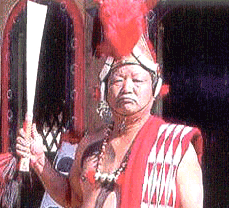 |
|
|
|
Dances of
Nagaland |
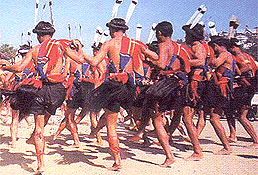 |
The Naga tribes
are fond of dances. These dances are mainly performed by men
in a group, except in Zeliang tribe where this dance is
performed equally by men and women. The Zemis of North Cachar
hills are very fond of dances. There are a number of dances
and each with a different name. They are named after the
manner in which hands and feet are executed to resemble the
movements of a bird or an insect or an animal like Nruirolians
or cock dance, Gethinglim or cricket dance, Temangnetin or
the fly dance and Hetateulee or the bear dance. All these
dances are performed with the songs and music.
|
|
|
UP |
|
Art & Craft
of Nagaland |
|
The important
handicrafts of the Nagas are wood-carving, bamboo work,
pottery and blacksmithy. The best wood-carvings can be seen on
the village gate, in the Morung, and in front of the house of
a rich man or warrior. The forests in Nagaland are rich in
Bamboo and cane so Nagas are the expert basket makers. Apart
from the baskets, the Nagas also make mats, shields, chungas
or drinking cups, necklaces, armlets and leggings with bamboo.
Pottery is not very popular and is practiced in very few
villages. Blacksmithy, a comparatively recent craft, is more
popular in Nagaland. The smiths produce the normal
requirements of villagers like the Dao, axe, sickle, knives,
spear points, butts and muzzle-loading guns. The Konyaks are
the best blacksmiths.
|
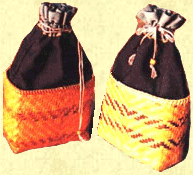 |
|
|
|
|
Wildlife Sanctuaries in
Nagaland |
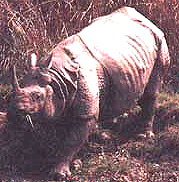 |
The Intaki Wildlife Sanctuary is the major wildlife sanctuary
of Nagaland. This sanctuary is the home of many endangered
species of wildlife. It is located around 37 km from Dimapur
and is the habitat of Hoolock Baboon, the only gibbon found in
India. The sanctuary also has a sizeable number of tuskers,
tigers, mithun, Sambhar, wild dog and sloth bear and some rare
species of birds. Besides this, the Ghosu Bird Sanctuary is
another sanctuary in Nagaland. This bird sanctuary is solely
maintained by the village community. This sanctuary is the
habitat of more than twenty species of endangered birds.
|
|
|
|
|

